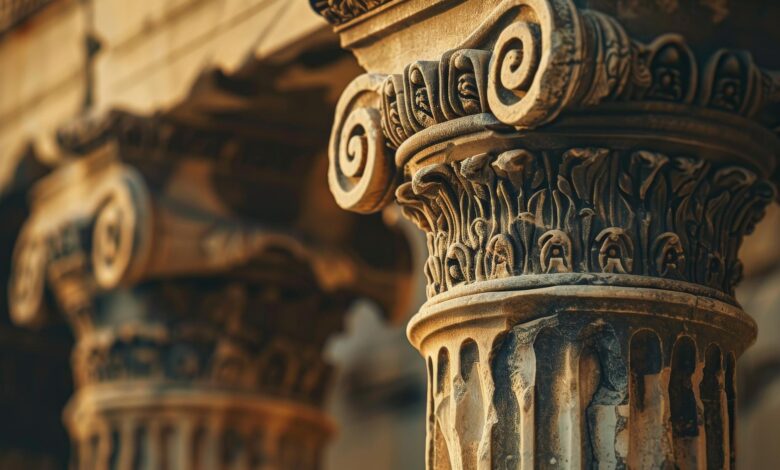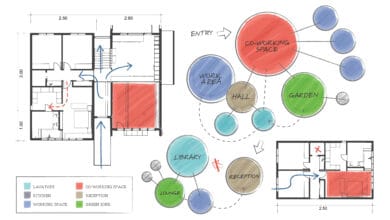Mastering Classical Design: Parts of a Column Architecture

Ever stopped to think about why classic columns are such iconic staples in Architecture? Columns aren’t just decorative pillars; they’re masterfully designed structures with crucial roles. So, what exactly makes these architectural elements both functional and visually stunning? Let’s break down the essential parts of a column Architecture to find out what gives these structures a sense of timelessness.
Modern building Architecture and design rely on various structural supports such as pillars, columns, rope support, and other design elements. Nonetheless, columns have played an important role in building support since antiquity. This is one of the reasons why many ancient buildings remain standing in their original form with no problems.
What is a Column in Architecture?
A column is a structural element that transfers loads from above to the structure below, typically characterized by a central shaft and a round cross-section. Classical columns, often made of stone, have evolved into modern versions crafted from materials like steel. In ancient Greek Architecture, three primary types of columns were predominantly used in building design.
History of Columns
Columns have their roots in Greco-Roman Architecture. Initially classified into three main architectural orders, they were later expanded with two additional Roman orders.
Originally, columns served as exterior pillars for sacred buildings like temples. Today, they are increasingly used in modern settings such as restaurants and hotels, where they offer structural support without dividing spaces, and add height and grandeur to interiors. Externally, columns enhance façades, imbuing buildings with a sense of nobility.
What is the Difference between Columns and Arches Architecture?
In the study of columns and arches Architecture, understanding the relationship between these elements and their distinct roles in structural integrity is important. Columns usually support only vertical loads, but their horizontal arrangement defines whether they can also help the bearing ends of arches or beams. Arches are best described as vertically curved or lattice structures that span an opening in a viaduct, aqueduct, or other type of crossing. They are not normally interchangeable, but they are likely to be interconnected.
Parts of a column Architecture
A Column has to provide major support, so it comprises various components. Some of the key parts of a column Architecture are listed below:
1. Base
The base is the lowest section of a column. While early Doric columns lacked a base, it became evident that a base was crucial for the stability of larger structures. A typical base consists of:
- Lower torus: A semicircular, convex molding.
- Scotia: A concave molding between two fillets.
- Upper torus: Completes the base structure.
Columns may also rest on more complex pedestals, which include a die (a square block between the column and base), a base, and a cornice, all set on a plinth to distribute weight evenly.
2. Shaft
The shaft is the long, vertical section of the column connecting the base to the capital. It provides height and consists of individual stacked circular sections known as the drum. The shaft often features “entasis,” a subtle curvature seen in classical columns.
Different architectural orders define the shaft’s characteristics:
- Doric: The Doric order, created by the Dorians, is known for its sturdy and simple design. It shares similarities with the Tuscan column but adds features like flutes along the shaft. In ancient Greece, Doric columns were placed directly on the floor without a base, emphasizing their robust nature. In Roman times, these columns became slimmer and were often set on an Attic base, blending strength with subtle elegance.
- Ionic: This order refines the Doric style by adding volutes—spiral scrolls on either side of the capital. These thinner, more elegant columns often feature flutes, adding to their delicate appearance. The Ionic order was famously used in the Temple of Diana at Ephesus, showcasing its balance of grace and detail.
- Corinthian: Originating in Corinth, the Corinthian order is the most ornate of the classical styles. The capital is adorned with acanthus leaves, inspired by a legend of leaves growing around a basket on a girl’s grave. This style is celebrated for its elaborate details, with slender, fluted columns symbolizing luxury and beauty.
- Tuscan: The last order on the list is the Tuscan order, from Tuscany, Italy, and is the simplest of the classical orders. Reflecting ancient architectural simplicity, it’s just a step beyond the basic post-and-lintel system. Tuscan columns are plain, and unfluted, with simple bases and capitals, embodying a functional, understated aesthetic.
3. Capital
The “Capital” is one of the most important components of an architectural column. It is the uppermost portion of a column. Important elements of a capital include:
- Astragal: A small convex molding around the bottom of the capital and the top of the shaft beneath the necking layer.
- Necking: A plain section beneath the capital in Doric columns.
- Abacus: A square slab sitting on top of a column’s capital and supporting the architrave or arch. The purpose of an abacus is to broaden the support provided by the column.
- Bell: A bell-shaped section of the capital, common in Corinthian columns, usually decorated with acanthus leaves.
- Volutes: A spiral form that distinguishes Ionic capitals.
- Echinus: The decorative molding beneath the abacus and above the necking.
Other Parts of a Column in Architecture
Although all major components have been discussed above, a few others are more commonly used in column design.
1. Bead and Reel
These decorations, featuring alternating or grouped circular or oval patterns, were popular in sixth-century stone sculptures and column supports.
2. Corbel
The Corbel is a detailed stone block, sometimes extending beside or directly designed on top of a column, providing support for integrated roofs or floors. The extra space in a column forms a 90-degree angle with the roof.
3. Cornice
A cornice is an important part that drains rainwater or other liquids from the column. The cornice provides strength to the column thus, preventing water accumulation that could weaken the structure.
4. Bed Mold
A rounded, convex molding beneath a corona or other molding. It is placed between the molding and the frieze and mainly for additional support and balance.
Conclusion
There are several parts of a column Architecture, some of which are mentioned above. Each part plays an important role in both structural integrity and aesthetic appeal. The base, shaft, and capital vary according to the architectural order (Doric, Ionic, Corinthian, etc.), which dictates the style and proportion of each part.



